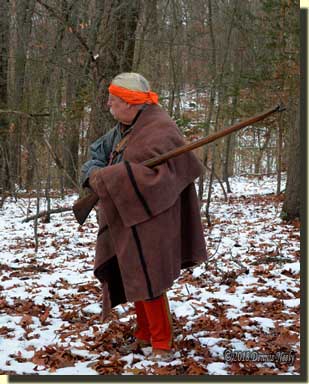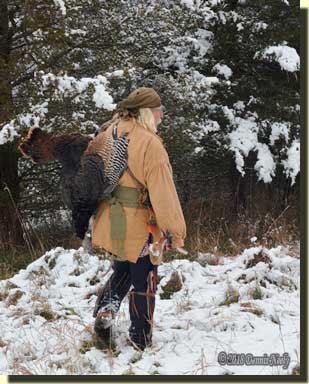Saturday, 17, December, 1763:
Frozen oak leaves crunched. Spotty snowflakes whisk about. Wool-lined moccasins tread light, slow and deliberate. The still-hunt progressed into a blustery southwest wind that sliced to the bone.
Two years prior, a summer thunderstorm broke a modest red oak high up, below the main fork. One limb came to rest on either side of a similar sized white oak. That tree, the white oak, grew a dozen or so paces below the crest of the second ridge east of the Riviere aux Raisins. The debris offered a prime vantage point for deer passing out of the river bottom on their way to a night frolic.

The returned captive scuffed away the leaves, pulled the once white trade blanket, bought with three large beavers, dyed brown with walnut hulls in a brass kettle, about his body. He sat cross-legged with his back to the trunk, facing into the wind. The French fusil, the muzzle pointed south, rested on the blanket tails that covered his madder-colored leggins.
A fat fox squirrel scrounged to the right, showing little concern. The critter hiked up a tall oak trunk, the one splintered in the thunderstorm. Nothing else moved about…
At dusk the wind ebbed. Orange and lavender painted the sky beyond the vast swamp that skirted the Riviere aux Raisins to the west. The water turned a shimmering silver as it wound back and forth through the tawny grasses. Canada geese ke-honked to the northeast. The honking faded to the north until it was heard no more.
A scrawny young doe browsed over the far rise. The deer angled down into the depression between the ridges, coming closer as the day slipped away. At the poplar stand, the forest tenant’s evening course turned northeast, sniffing the ground, then pausing to lick green moss on a rotting tree trunk. It appeared she would pass by, beyond the fusil’s effective distance.
This deer, that summer’s fawn, offered little sustenance. “Bones and hide,” Mi-ki-naak whispered. With the cold, she was not worth the effort to dress and pack back to camp. Each hoof fall crunched, louder and louder. She did not raise her head, did not check her back trail nor search for danger ahead.
At seven paces distant, her head rose up slow. She stopped. She sensed danger, gazed to the south, glanced the north, then looked up the rise to the ridge crest. As his adoptive Ojibwe father taught him, Mi-ki-naak squinted so the deer would not see his eyes. The young doe’s ears perked. Hams tensed. Back hair bristled. Her head dropped as her tongue licked her black nose.
The doe snorted, more a sneeze than a warning blow, then turned about and took four bounds down the hill and with the wind. She stopped, looked back and sniffed. What little breeze remained, light but still noticeable, carried the returned captive’s scent away from the deer’s keen nose.
She stomped three times. Time passed. Unsure, she took four bounds, the kind that do not produce distance, but rather undertaken to elicit movement on the part of an unknown foe. Again her right foreleg crashed in the leaves. She stood in silence until darkness fell. The oak leaves crunched as she walked off.
Huddling in a cold, shivery silence, nose dripping, Mi-ki-naak, Snapping Turtle in the English tongue, waited. In time he got to his feet, rubbed his hands and walked off in the direction whence he came…
Many Moccasin Steps Back…
A guiding premise of any traditional black powder hunt is a passionate desire to forsake “what is” for “what was.” The attraction of this hunting philosophy is to let go of the here and now and embrace a turning back of the clock to the ways of our ancestors. For some, this transition in thinking requires little forethought or effort, for others there is fierce wrenching of hands accompanied by great trepidation.
Seventy years ago, Aldo Leopold penned some pretty powerful words. He addressed the degradation of hunting and also of the environment and conservation. The following is a favorite passage from an essay entitled “Wildlife in American Culture,” which appears near the end of his classic work, A Sand County Almanac:
“Then came the gadgeteer, otherwise known as the sporting-goods dealer. He has draped the American outdoorsman with an infinity of contraptions, all offered as aids to self-reliance, hardihood, woodcraft, or marksmanship, but too often functioning as substitutes for them. Gadgets fill the pockets, they dangle from neck and belt. The overflow fills the auto-trunk, and also the trailer. Each item of outdoor equipment grows lighter and often better, but the aggregate poundage becomes tonnage. The traffic in gadgets adds up to astronomical sums, which are soberly published as representing ‘the economic value of wildlife.’ But what of cultural values?
“As an end-case, consider the duck-hunter, sitting in a steel boat behind composition decoys. A put-put motor has brought him to the blind without exercise. Canned heat stands by to warm him in case of a chilling wind. He talks to the passing flocks on a factory caller, in what he hopes are seductive tones; home lessons from a phonograph record have taught him how. The decoys work, despite the caller; a flock circles in. It must be shot at before it circles twice, for the marsh bristles with other sportsmen, similarly accoutered, who might shoot first. He opens up at 70 yards, for his poly-choke is set for infinity, and the advertisements have told him that Super-Z shells, and plenty of them, have a long reach. The flock flares. A couple of cripples scale off to die elsewhere. Is this sportsman absorbing cultural value? Or is he just feeding minks?…Where is the go-light idea, the one-bullet tradition?” (Leopold, 180).
Now we’ve just finished a wild turkey season in Michigan. Many of the stories posted online sing the praises of items Leopold classified as “contraptions” or “gadgets.” Others bemoan the fact that “…the gobbler hung up and didn’t come in,” “in” being within 50 yards of the modern-day version of “the poly-choke” and “Super-z” plastic suppositories.

And then there is the lowly traditional hunter, sitting under a red cedar tree, dressed in the clothing of a mustered-out member of Joseph Hopkins Company of Rangers or a returned white captive, given the Ojibwe name of Mi-ki-naak. The arms used are smooth-bored flintlocks, appropriate for each historical persona. Oh, and the effective distance of those firelocks is 25 paces—the former being close to 28 yards because that living historian’s stride is longer than Mi-ki-naak’s and his English fowler is bored larger than the French fusil.
Leopold’s words are prefaced by three “cultural values,” each of which survives with most traditional black powder hunts.
“First there is value in any experience that reminds us of our distinctive national origins and evolution, i.e. that stimulates awareness of history…I shall call this…the ‘split-rail value…”
“Second, there is value in any experience that reminds us of our dependency on the soil-plant-animal-man food chain, and of the fundamental organization of the biota. Civilization has so cluttered this elemental man-earth relation with gadgets and middlemen that awareness of it is growing dim…”
“Third, there is value in any experience that exercises those ethical restraints collectively called ‘sportsmanship”…
“Voluntary adherence to an ethical code elevates the self-respect of the sportsman…voluntary disregard of the code degenerates and depraves him…”
Here again, Leopold continues with an explanation of the values that seemed to be slipping away from outdoor folks in the late 1940s:
“The pioneer period gave birth to two ideas that are the essence of split-rail values in outdoor sports. One is the ‘go-light’ idea, the other the ‘one-bullet-one-buck’ idea…” (Ibid, 177 – 179)
In a broader sense, if a convert or newcomer gives traditional hunting, either black powder or archery, a fair test, the dependence of the modern philosophy on contraptions and gadgets becomes obvious. In most instances, the addictive nature of venturing back to yesteryear takes hold. The apprehension lingers for quite some time, and that is natural. It is difficult to give up “guaranteed success” for an “unknown maybe.” And this is the essence of the salesman pushing the modern inline over the unreliable and outdated side hammer.
A number of years ago, at the Woods-N-Water News Outdoor Weekend, a gentleman in his mid-50s started asking questions about traditional black powder hunting. In the conversation he stated that it was his “lifelong dream” to take a whitetail using a Model 1863 Springfield rifled musket, dressed as a returned Civil War veteran. I think he had been a Civil War era re-enactor in his younger days. He owned the rifle and most of the clothing.
Now this fellow had a dozen reasons why he couldn’t achieve his dream, the biggest was giving up his heated “people box,” as Miss Tami calls today’s deer houses. Over the next half hour, both Tami and I knocked down all of his objections, but he still persisted.
Our demonstration area was busy that day, as it most often is. Near the end of the conversation, another fellow walked by, stopped, touched my shoulder and said, “I just wanted to let you know that I took a deer with my Springfield musket last fall. What a thrill. I didn’t know what I was missing.” His timing was perfect.
Tami and I talked about it in the evening. We don’t believe we convinced the naysayer to venture back, to attempt to achieve his lifelong dream, but we weren’t sure about the gentleman that stopped by, either.
Give traditional black powder hunting a try, be safe and may God bless you.


